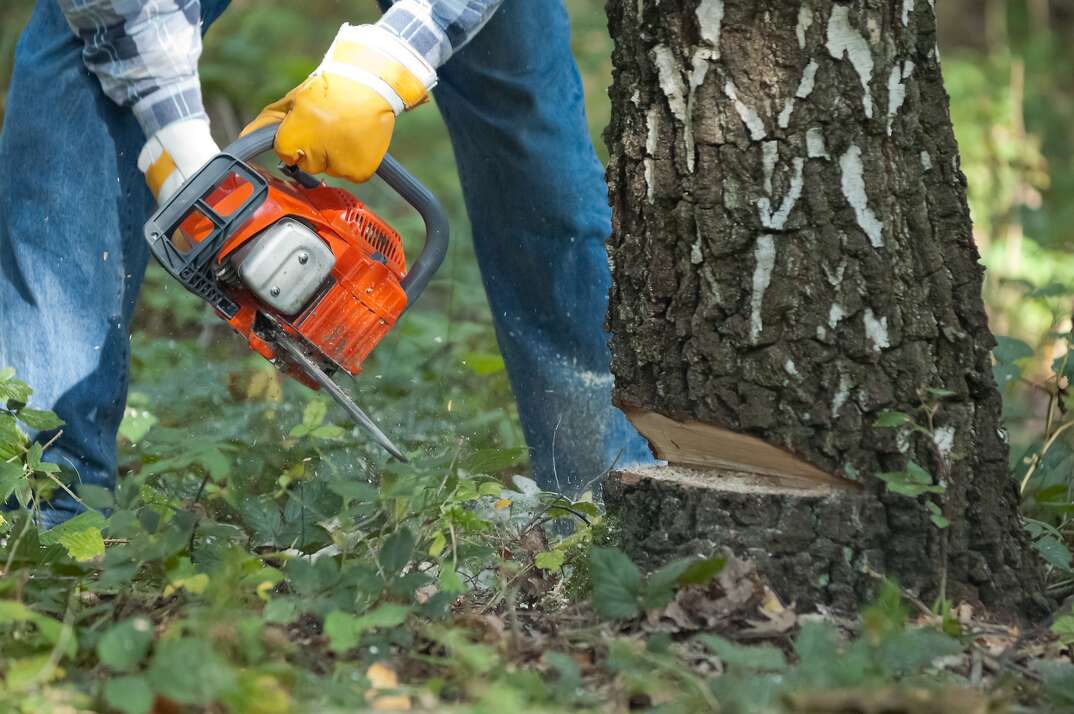- AppliancesElectriciansHVACLandscapingLocksmithPest ControlPlumbingRenovationRoofingT V RepairAll Home Improvement
- Car AccidentClass ActionCorporate LawCriminal DefenseDivorce LawEmployment LawFamily LawFinancial LawLegal AidMedical Injury LawyersMedical MalpracticeReal Estate LawWater Fire RestorationAll Legal
- InvestmentRetirementAll Finance
- Animal InsuranceAutoGeneral InsuranceHealth PolicyHome RentersAll Insurance
- DentalHealth SpecialistsAll Medical
- Animal CareVeterinaryAll Pets
- Auto GlassTowingAll Automotive
7 Tips for Cutting Down a Tree

It’s time: That one tree in your backyard has got to go. Cutting down a tree may seem like a simple enough task, but it's essential to know how to do it safely.
Below, you can find our top tree-cutting tips.
1. Dress for Safety
Wearing the right protective gear for tree cutting could save your life. Wearing a logger's helmet can protect your head from falling branches, and safety goggles stop any debris from damaging your eyes.
You'll need additional protection if you're using a chainsaw for tree cutting. Ear defenders protect your ears from noise, and you should also wear a face screen. It's also essential to wear Kevlar chaps that will stop the chain if it touches your leg.
2. Check the Area
Before you start work, ensure that kids and pets are safely indoors and that anyone who uses your yard is aware that you're cutting a tree down. Next, check the area for anything that could get damaged by a falling tree and move it out of the way.
Don't forget to look up — felling a tree could potentially damage nearby power lines. If in doubt, it's safer to hire a professional to cut the tree down for you.
3. Select the Falling Direction
You can often manipulate a tree to fall in a certain direction, ideally towards a clear area. Tying ropes to the tree and asking helpers to pull it in the falling direction can help encourage it to fall the way you want it to. Ensure that your helpers are ready and able to move quickly out of the way if necessary.
4. Estimate the Fall Zone
You can estimate how much space your tree needs to fall using a simple trick. Hold an ax with your arm out straight and at 90 degrees to your body. Next, close one eye and focus on the top of the ax, slowly back away in the direction you want the tree to fall until the treetop lines up with the ax tip.
Your feet mark the rough position where the treetop will land, making it easier to know how much space to clear. However, it's wise to allow an extra couple of feet to be on the safe side.
5. Cut a Notch — the Right Way
Cutting a notch in the tree trunk can make it easier to cut down. It also encourages the tree to fall in the right direction. Create the notch at a comfortable working height and on the same side that you want it to fall.
Aim to cut through around one-fifth of the trunk's diameter. The top cut should be at roughly 60-degrees to the ground, and the bottom cut should be at around a 30-degree angle.
6. Cut the Tree Down Safely
Plan several routes of escape away from the tree so that you're ready to move quickly, even if it falls in an unexpected direction. You should place the felling cut on the opposite side of the trunk to the notch and level with the notch apex. Saw towards the notch until the tree begins to lean.
As soon as you notice leaning, remove the saw. Apply the chain brake if you're using a chainsaw and immediately move out of the way. Keep an eye on the tree at all times as you move away.
7. Use a Lookout
It can be hard to know when the tree starts to lean from your cutting position, and there's also a risk of branches falling on you while you work. Ask a lookout to stand a few feet behind you and give them a long object to poke you with as soon as they notice the tree move or if a branch looks like it's going to fall. Be prepared to move away immediately as soon as they touch you with the object, even if you don't think the tree is about to fall.
Elocal Editorial Content is for educational and entertainment purposes only. Editorial Content should not be used as a substitute for advice from a licensed professional in your state reviewing your issue. Systems, equipment, issues and circumstances vary. Follow the manufacturer's safety precautions. The opinions, beliefs and viewpoints expressed by the eLocal Editorial Team and other third-party content providers do not necessarily reflect the opinions, beliefs and viewpoints of eLocal or its affiliate companies. Use of the Blog is subject to the
Website Terms and Conditions.The eLocal Editorial Team operates independently of eLocal USA's marketing and sales decisions.

